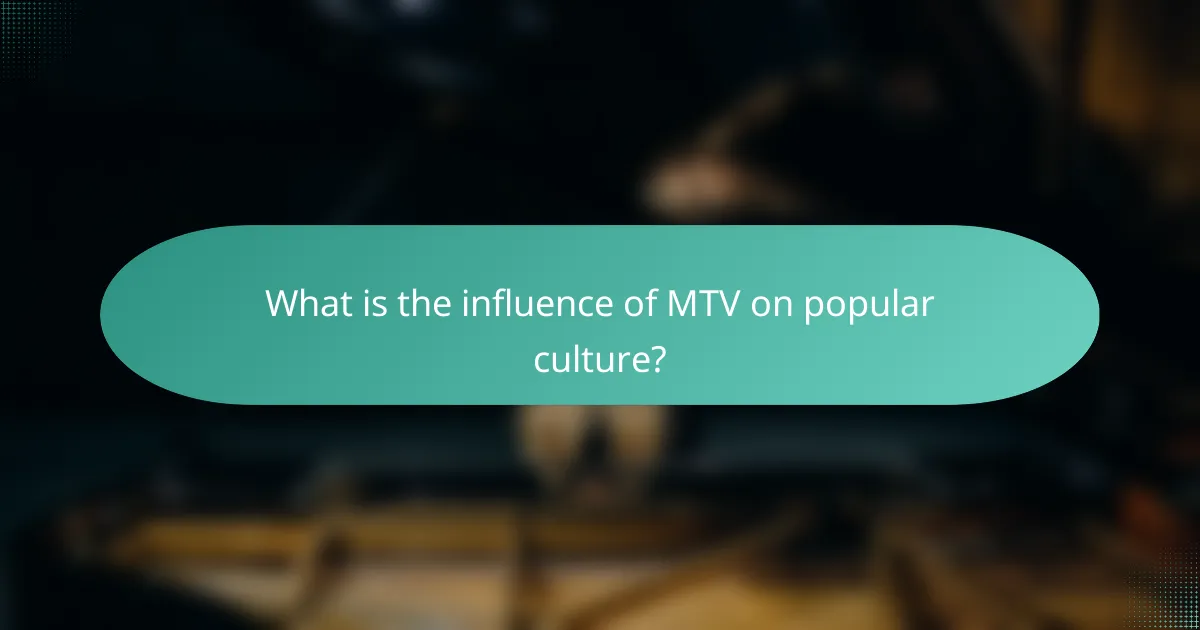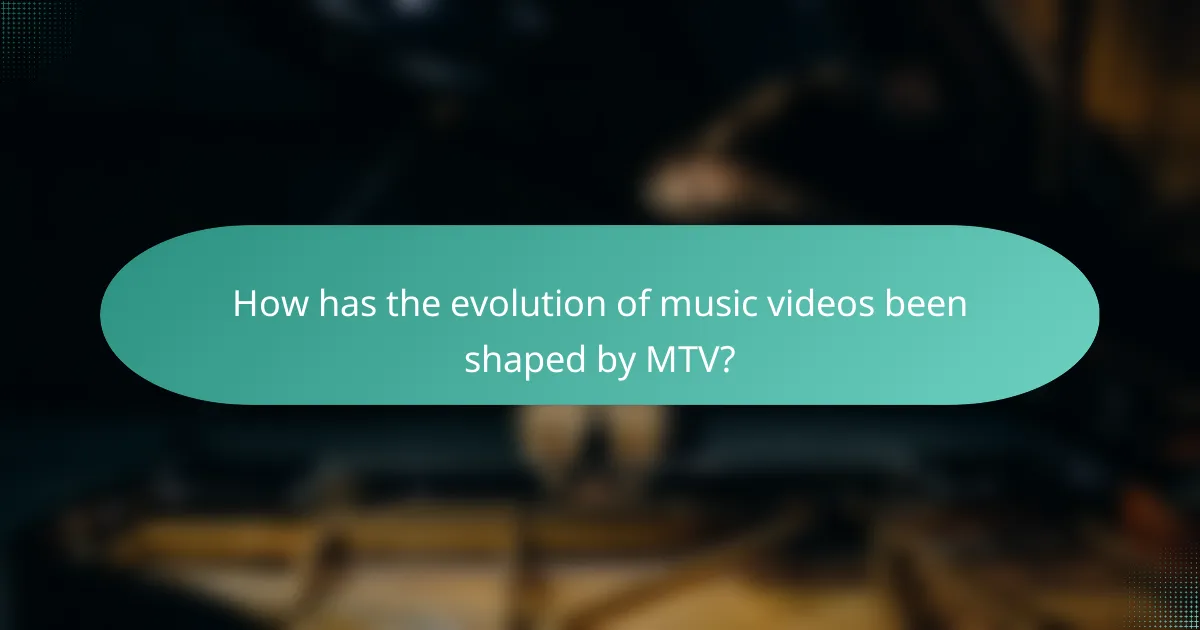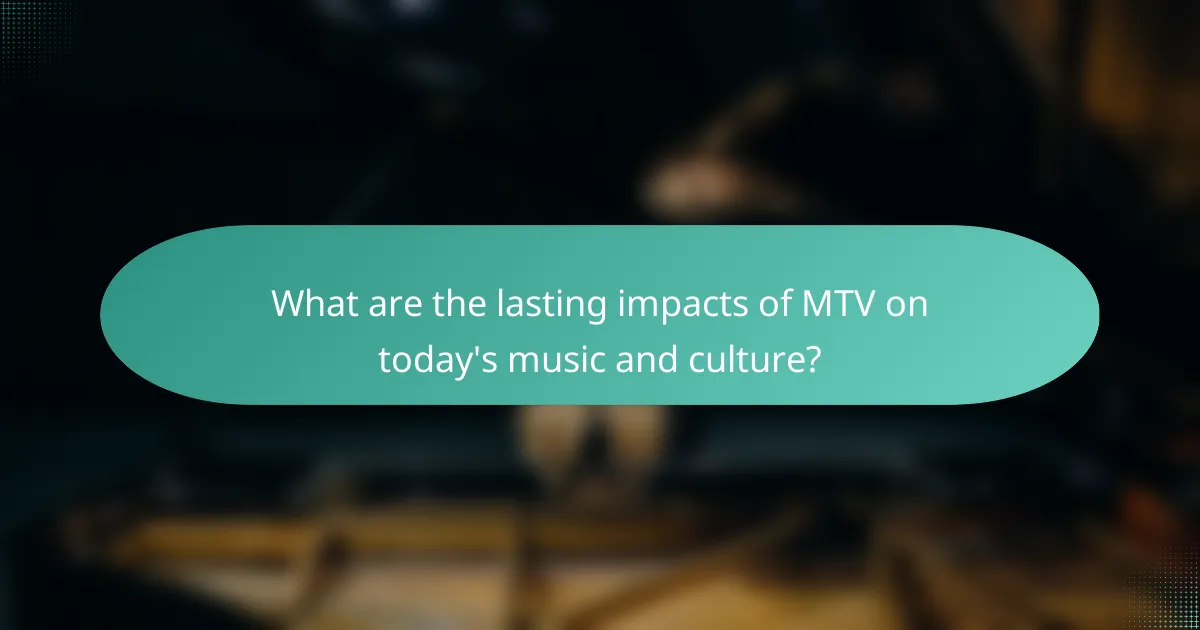MTV, a music television network launched in 1981, has played a pivotal role in transforming popular culture and the music industry. It popularized music videos as essential promotional tools, significantly enhancing the visibility of artists such as Madonna and Michael Jackson. By showcasing diverse musical genres, including hip-hop and alternative rock, MTV broadened the musical landscape and influenced audience preferences. The network also impacted fashion trends and youth culture through its innovative programming, including the reality television format. MTV’s legacy continues to shape today’s music and entertainment industries, where visual presentation remains a crucial element in artist promotion.

What is the influence of MTV on popular culture?
MTV has significantly influenced popular culture since its launch in 1981. It revolutionized the music industry by popularizing music videos as a primary promotional tool. Artists like Madonna and Michael Jackson became cultural icons partly due to their innovative videos aired on MTV. The network introduced diverse genres, showcasing hip-hop and alternative rock, which broadened the musical landscape. MTV also shaped fashion trends and youth culture through its programming. Its shows, like “The Real World,” pioneered reality television, impacting how stories are told in media. MTV’s influence is evident in today’s music and entertainment industries, where visual presentation remains crucial.
How did MTV change the music industry landscape?
MTV fundamentally changed the music industry landscape by introducing music videos as a key promotional tool. The channel launched on August 1, 1981, and quickly became a platform for artists to showcase their music visually. This shift allowed musicians to reach broader audiences through compelling visuals. MTV’s emphasis on music videos created a new genre of entertainment and marketing. Artists like Michael Jackson and Madonna gained immense popularity partly due to their innovative music videos. The channel also influenced music production trends, incorporating visual storytelling in music. By prioritizing image and style, MTV altered how artists were marketed and perceived. This transformation had lasting effects on the music industry, shaping the careers of numerous artists and the overall music consumption experience.
What role did MTV play in artist promotion?
MTV played a pivotal role in artist promotion by revolutionizing how music was marketed. The channel provided a platform for artists to showcase their music videos, significantly increasing their visibility. This exposure often translated into record sales and mainstream success. MTV’s emphasis on visual appeal changed the music industry landscape. Artists like Michael Jackson and Madonna became global icons partly due to their innovative videos aired on the channel. The network also introduced programs that featured emerging artists, further enhancing their reach. In the 1980s and 1990s, MTV was instrumental in defining pop culture and music trends. Its influence helped shape the careers of many artists, making it a crucial component of music promotion during its peak.
How did MTV impact music consumption habits?
MTV significantly transformed music consumption habits by prioritizing visual content. The launch of MTV in 1981 introduced music videos as a primary medium for promoting songs. This shift encouraged artists to create visually engaging content to attract viewers. Consequently, music consumption became more tied to visual aesthetics rather than just audio. By the mid-1980s, music videos heavily influenced chart performance, with hits often correlated to their video popularity. The platform also shaped audience preferences, making genres like pop and rock mainstream. MTV’s emphasis on music videos led to the rise of iconic artists who utilized this format to enhance their reach. Overall, MTV revolutionized how audiences interacted with music, merging audio and visual experiences.
What cultural shifts can be attributed to MTV’s programming?
MTV’s programming has significantly influenced cultural shifts in music, fashion, and youth identity. The channel popularized music videos as an art form, changing how artists presented their work. It introduced a visual culture that emphasized style and image alongside music. MTV also contributed to the rise of genres like hip-hop and alternative rock, giving them mainstream exposure. The programming often reflected and shaped societal attitudes towards race and gender. For instance, the inclusion of diverse artists challenged racial barriers in the music industry. Events like “The Real World” pioneered reality television, impacting how youth culture was portrayed. Overall, MTV’s programming played a crucial role in defining pop culture from the 1980s onward.
How did MTV influence fashion and youth culture?
MTV significantly influenced fashion and youth culture by popularizing music-driven trends. The network showcased iconic artists whose styles became emulated by young viewers. For example, Madonna’s bold fashion choices in the 1980s set trends that defined an era. The channel’s music videos often featured elaborate costumes, encouraging viewers to adopt similar looks. Additionally, MTV introduced the concept of the music video as a visual art form, merging fashion with music. This integration allowed designers to gain exposure through artist collaborations. As a result, MTV became a cultural touchstone for youth identity and self-expression. The impact of MTV on fashion can be seen in the rise of streetwear and the blending of various fashion genres.
What social movements were highlighted by MTV content?
MTV content highlighted several significant social movements. These include the [censured] rights movement, which was prominently featured in various programs and music videos. The network also spotlighted the anti-apartheid movement through music and artist activism. Environmental awareness was another focus, especially during events like “MTV’s Rock the Vote.” Additionally, MTV addressed issues related to racial equality, particularly during the Black Lives Matter movement. The network’s programming often included discussions on mental health awareness, promoting open conversations among youth. Each of these movements was reinforced by artists using their platforms to advocate for change.

How has the evolution of music videos been shaped by MTV?
MTV significantly shaped the evolution of music videos by introducing a new visual medium for music promotion. Launched in 1981, MTV revolutionized how artists presented their music. The channel emphasized the importance of visuals in music, leading to the creation of iconic music videos. Artists like Michael Jackson and Madonna leveraged MTV to enhance their visibility and popularity. The platform also established a standard for production quality and creativity in music videos. By featuring diverse genres, MTV influenced musical trends and audience preferences. The network played a crucial role in launching the careers of numerous artists through its music video rotation. MTV’s impact is evident in how music videos became essential marketing tools for artists, shaping the music industry’s landscape.
What are the key milestones in music video history on MTV?
MTV revolutionized music videos with several key milestones. The network launched on August 1, 1981, with the first music video, “Video Killed the Radio Star” by The Buggles. This marked the beginning of music videos as a significant cultural force. In 1983, Michael Jackson’s “Thriller” premiered, setting new standards for production quality and storytelling. The video became a cultural phenomenon and remains iconic. In 1984, MTV aired its first live concert, featuring The Cars, showcasing the potential for live performances in music videos. The network introduced the “MTV Video Music Awards” in 1984, celebrating music videos and artists. In the 1990s, artists like Nirvana and Madonna pushed boundaries, influencing the direction of music videos. By the early 2000s, MTV began to diversify its programming, impacting the music video landscape. These milestones collectively shaped the evolution of music videos and their role in popular culture.
How did the introduction of music videos change artist branding?
The introduction of music videos significantly changed artist branding by providing a visual platform for identity expression. Artists could now convey their image and style through carefully crafted visuals. This visual storytelling enhanced their appeal and engagement with audiences. Music videos became essential tools for marketing and promotion. They allowed artists to differentiate themselves in a crowded market. The rise of MTV in the 1980s accelerated this shift, making music videos a cultural phenomenon. Artists like Michael Jackson and Madonna leveraged visuals to create iconic brands. This transformation established a new standard for artist visibility and connection with fans.
What innovations in music video production emerged from MTV?
MTV introduced several key innovations in music video production. These innovations included the use of narrative storytelling within videos. This approach enhanced viewer engagement and provided a deeper connection to the music. MTV also popularized the concept of high production values in music videos. Artists began to invest significantly in visual aesthetics and cinematography. The channel introduced the integration of special effects and animation. This allowed for creative expression beyond traditional filming techniques. Additionally, MTV emphasized the importance of a strong visual identity for artists. This led to iconic branding through music videos. The rise of music video directors as key creative figures also emerged during this era. Notable directors like David Fincher and Michel Gondry shaped the future of music video artistry. Overall, MTV transformed music videos into a vital aspect of music marketing and cultural expression.
What styles and genres of music have been popularized by MTV?
MTV has popularized several music styles and genres. These include pop, rock, hip-hop, and alternative music. The network’s launch in 1981 coincided with the rise of music videos as a marketing tool. Pop music gained immense visibility through artists like Madonna and Michael Jackson. Rock music also thrived, with bands like Duran Duran and Bon Jovi gaining fame. Hip-hop emerged as a significant genre through artists like Run-D.M.C. and Beastie Boys. Alternative music found a platform with bands like Nirvana and R.E.M. MTV’s influence reshaped the music industry by emphasizing visual presentation. The channel played a crucial role in the careers of many artists across these genres.
How has MTV contributed to the rise of specific music genres?
MTV significantly contributed to the rise of specific music genres, particularly pop, hip-hop, and rock. The launch of MTV in 1981 revolutionized music promotion through visual media. It provided a platform for artists to showcase their music through innovative music videos. This visual aspect attracted a broader audience and created a cultural phenomenon.
Pop music gained immense popularity due to artists like Michael Jackson and Madonna, whose music videos became iconic. Hip-hop also saw a surge in visibility with the success of artists like Run-D.M.C. and later, artists like Tupac and Notorious B.I.G. Their music videos introduced hip-hop culture to mainstream audiences.
Rock music was further popularized through the exposure of bands like Guns N’ Roses and Nirvana. MTV’s “Headbangers Ball” and “Unplugged” series showcased rock artists, solidifying their presence in the music scene.
MTV’s influence extended beyond music videos. It shaped trends and styles, impacting fashion and youth culture. The channel’s awards shows, like the MTV Video Music Awards, celebrated diverse genres, further promoting them.
Overall, MTV’s role in music genre promotion was pivotal, as it transformed how music was consumed and appreciated.
What impact did MTV have on global music trends?
MTV significantly influenced global music trends by popularizing music videos as a primary promotional tool. This shift changed how artists presented their music visually. The network introduced new genres to wider audiences, including hip-hop and pop. MTV also established the concept of the music video premiere, creating anticipation for new releases. The channel’s focus on visual aesthetics shaped artists’ branding and image. MTV’s global reach helped international artists gain exposure in the U.S. market. By the late 1980s, MTV had become a cultural phenomenon, impacting fashion and youth culture. Its influence is evident in the ongoing importance of music videos in marketing strategies today.

What are the lasting impacts of MTV on today’s music and culture?
MTV has had a profound and lasting impact on today’s music and culture. It revolutionized the way music is consumed by integrating visual storytelling with music. The launch of MTV in 1981 marked the beginning of music videos as a critical promotional tool for artists. Artists like Madonna and Michael Jackson leveraged the platform to enhance their image and reach global audiences. MTV also introduced genres like hip-hop and alternative rock to mainstream culture. The network’s focus on visual aesthetics set new standards for music production and marketing. Additionally, MTV’s influence extends to fashion and youth culture, shaping trends and societal norms. The channel’s legacy continues to be felt through platforms like YouTube and social media, where visuals are essential to music promotion today.
How does MTV’s legacy influence contemporary artists?
MTV’s legacy significantly influences contemporary artists by shaping music video production and promotion. The network revolutionized how music is marketed and consumed. It introduced the concept of visual storytelling in music, which remains vital today. Artists now prioritize visually engaging content to capture audience attention. MTV also established the importance of celebrity culture in music. This phenomenon encourages artists to cultivate their public personas actively. Additionally, MTV’s emphasis on diverse genres paved the way for genre-blending in contemporary music. The network’s impact is evident in the rise of platforms like YouTube, where music videos are essential for artist visibility. Overall, MTV’s legacy continues to drive innovation and creativity in the music industry.
What lessons can modern artists learn from MTV’s approach?
Modern artists can learn the importance of visual storytelling from MTV’s approach. MTV revolutionized music promotion by integrating compelling visuals with music. This combination captured audience attention and enhanced emotional connection. Artists should prioritize high-quality music videos to engage viewers. Additionally, MTV’s focus on branding helped artists create strong identities. A distinct aesthetic can differentiate artists in a crowded market. MTV also utilized innovative marketing strategies, such as collaborations and cross-promotions. These tactics expanded reach and audience engagement. Finally, MTV’s emphasis on audience interaction through contests and fan participation fostered community. Modern artists can replicate these strategies to build loyal fan bases.
How does MTV continue to shape music marketing strategies?
MTV continues to shape music marketing strategies by leveraging its platform to promote artists through innovative visual content. The channel popularized music videos as essential marketing tools in the 1980s. It established the concept of visual branding for musicians. Artists now create compelling narratives through their videos to engage audiences. MTV also influences trends in music consumption through its programming and awards shows. The channel’s focus on youth culture drives artists to tailor their marketing strategies accordingly. Recent collaborations with social media platforms further amplify music exposure. This integration ensures that music marketing adapts to changing consumer behaviors.
What practical insights can we gain from MTV’s influence?
MTV’s influence provides practical insights into media’s role in shaping cultural trends. It revolutionized music consumption by making music videos a primary promotional tool. This shift increased the importance of visual storytelling in music. Artists began to craft their images carefully to align with video content. MTV also highlighted the significance of youth culture in marketing strategies. It demonstrated the power of niche audiences in driving mainstream success. The network’s impact on fashion and lifestyle trends remains evident today. Overall, MTV’s influence underscores the interconnectedness of music, media, and culture.
How can emerging artists leverage MTV’s historical impact for success?
Emerging artists can leverage MTV’s historical impact by utilizing its platform for visibility and engagement. MTV has a legacy of launching music careers through its influential music videos. Artists can create visually compelling content that resonates with MTV’s audience. Collaborating with established artists featured on MTV can enhance credibility and reach. Engaging with MTV’s social media channels can help artists connect with fans. Participating in MTV events or contests can provide exposure to a wider audience. Historically, artists like Madonna and Nirvana gained fame through MTV’s innovative programming. This demonstrates the potential for emerging artists to achieve similar success by tapping into MTV’s established influence.
What strategies can be adopted from MTV’s promotional tactics?
MTV’s promotional tactics can be adopted through several key strategies. First, leveraging celebrity endorsements effectively attracts attention. MTV utilized popular artists to promote their brand, which increased viewer engagement. Second, creating visually captivating content is essential. MTV’s music videos were known for their innovative visuals, making them memorable. Third, utilizing social media platforms enhances reach. MTV engaged audiences on platforms like Twitter and Instagram, fostering community interaction. Fourth, hosting live events generates excitement. MTV’s annual Video Music Awards created buzz and drew large audiences. Finally, embracing cultural relevance keeps content fresh. MTV often aligned its programming with current trends and social issues, resonating with viewers. These strategies have proven effective in driving audience engagement and brand loyalty.
The main entity of the article is MTV, a television network that has had a profound impact on popular culture since its launch in 1981. The article examines MTV’s influence on the music industry, including the promotion of music videos as a key marketing tool, the shaping of artist branding, and the evolution of music consumption habits. It also discusses how MTV’s programming has led to significant cultural shifts in fashion, youth identity, and social movements. Key milestones in music video history, as well as the lasting effects of MTV on contemporary music and culture, are highlighted, providing insights into how emerging artists can leverage MTV’s historical impact for success.